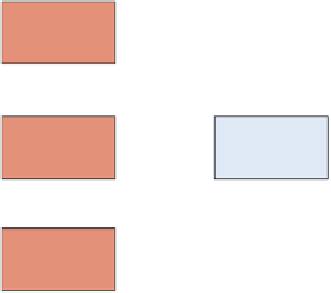Database Reference
In-Depth Information
Relational Databases:
Oracle Database,
Microsoft SQL Server,
MySQL, Microsoft Access,
IBM DB2 . . .
Nonrelational
Databases
Browser
VSAM, ISAM, Other
File Processors
Web
Server
Browser
E-mail, Other
Document Types
Browser
Figure 11-1
the Variety of Data types in
Web Database applications
Pictures, Audio,
Other????
DB2 mainframe database; a non-relational database, such as IMS, IBM's older DBMS product; file-
processing data, such as VSAM and ISAM; e-mail directories; and so forth. Each one of these prod-
ucts has a different programming interface that the developer must learn. Further, these products
evolve, thus new features and functions will be added over time that will increase the developer's
challenge.
Several standard interfaces have been developed for accessing database servers. Every
DBMS product has an
application programming interface (API)
. An API is a collection of ob-
jects, methods, and properties for executing DBMS functions from program code. Unfortunately,
each DBMS has its own API, and APIs vary from one DBMS product to another. To save program-
mers from having to learn to use many different interfaces, the computer industry has developed
standards for database access.
The
Open Database Connectivity (ODBC)
standard was developed in the early
1990s to provide a DBMS-independent means for processing relational database data. In
the mid-1990s, Microsoft announced
OLE DB
, which is an object-oriented interface that
encapsulates data-server functionality. OLE DB was designed not just for access to rela-
tional databases, but also for accessing many other types of data as well. As a
Component
Object Model (COM)
interface, OLE DB is readily accessible to programmers through the
use of programming languages such as C, C#, and Java. However, OLE DB is not as accessible
to users of Visual Basic (VB) and scripting languages. Therefore, Microsoft developed
Active
Data Objects (ADO)
, which is a set of objects for utilizing OLE DB that is designed for use
by any language, including Visual Basic (VB), VBScript, and JScript. ADO has now been
followed by
ADO.NET
(pronounced “A-D-O-dot-NET”), which is an improved version of
ADO developed as part of Microsoft's .NET (pronounced “dot-NET”) initiative and a compo-
nent of the .NET Framework.
ADO technology is use to build Web pages as part of Microsoft's
Active Server Pages
(ASP)
technology, which are then used to create Web-based database applications. ASP is a com-
bination of Hypertext Markup Language (HTML) and VBScript or JScript that can read and write
database data and transmit it over public and private networks, using Internet protocols. ASP
runs on Microsoft's Web server product,
Internet Information Services (IIS)
. When ADO.NET
was introduced, Microsoft also introduced
ASP.NET
. ASP.NET is the successor to ASP and is the
preferred Web page technology in the .NET Framework.
Of course, there are other connectivity methods and standards besides those propagated
by Microsoft. The main alternatives to ADO.NET technology are based on or associated with
Oracle Corporation's
Java platform
and include the
Java programming language
,
Java
Database Connectivity (JBDC)
,
Java Data Objects (JDO)
, and
JavaServer Pages (JSP)
.



















































































































































































































































































































































































































































































































Search WWH ::

Custom Search